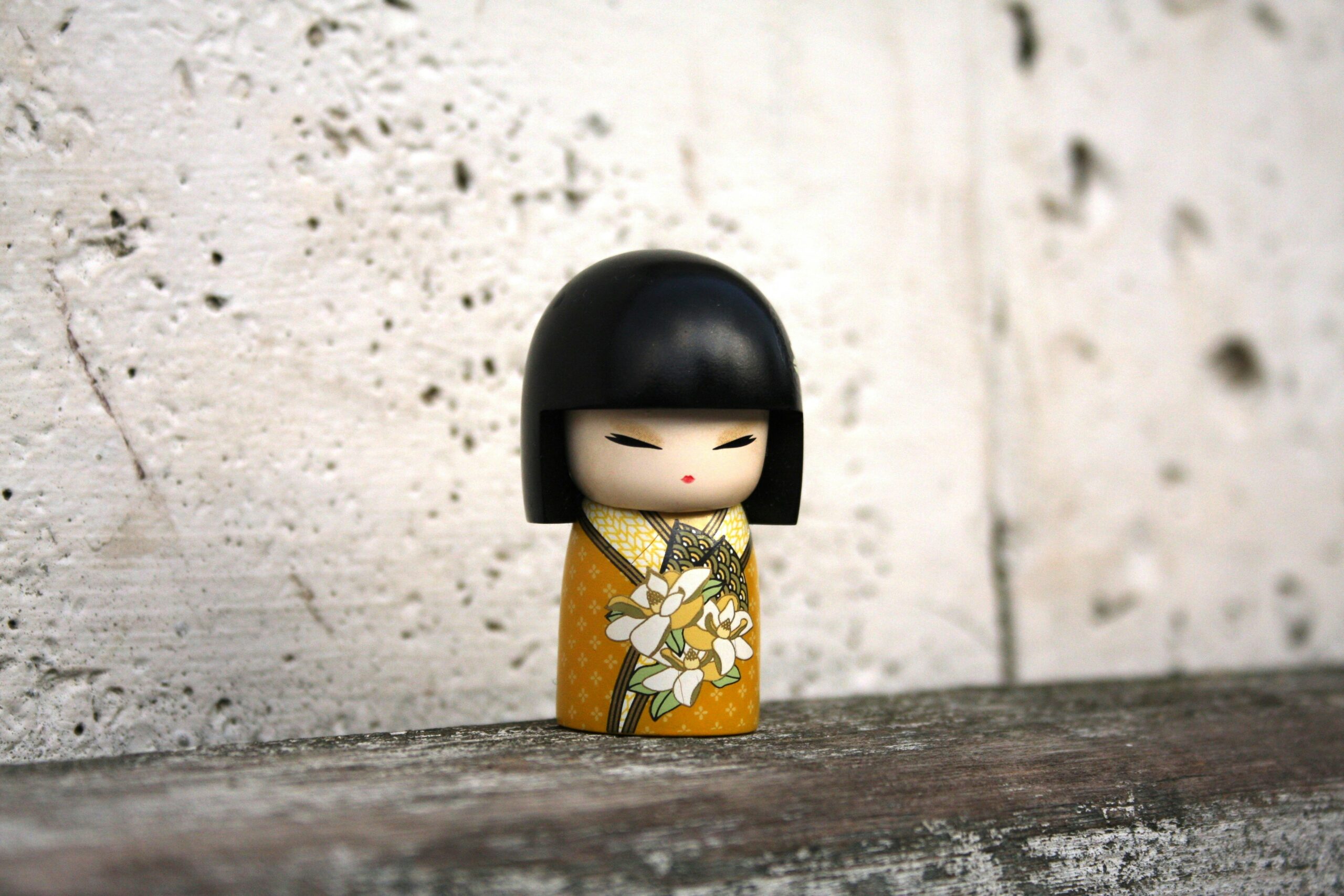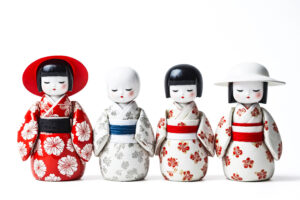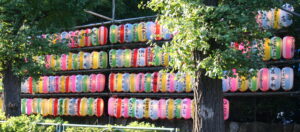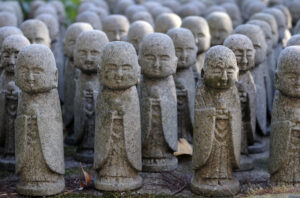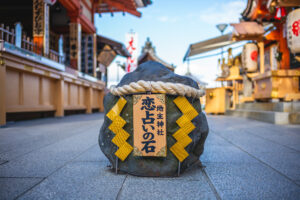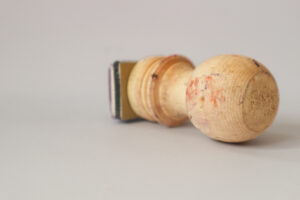In the heart of Japan, a tradition as timeless as the serene landscapes from which it was born continues to capture the hearts of people around the world. Kokeshi dolls, with their simple yet captivating forms, are more than just wooden figures; they are a testament to Japan’s rich cultural history and a symbol of its artistic heritage. These traditional dolls, characterized by their lack of arms and legs and their elaborate painted designs, hold a special place in the realm of Japanese crafts. As we delve into the world of Kokeshi dolls, we uncover not only their ancient origins but also the meticulous crafting techniques passed down through generations, the profound symbolism behind their designs, and the unwavering dedication of artisans committed to preserving this craft. From their role in Japanese festivals to the challenges faced by today’s craftsmen, the story of Kokeshi dolls is a fascinating journey through time, art, and tradition.
The Ancient Origins of Kokeshi Dolls
Kokeshi dolls trace their roots back to the Edo period (1603-1868) in the Tohoku region of northern Japan. Initially created by kijiya (woodworkers) as toys for children or as souvenirs for the hot spring visitors, these dolls have evolved but always carried the essence of Japanese aesthetics and spirituality. The term "Kokeshi" itself is believed to derive from a combination of names and terms associated with the dolls’ production and the wooden materials used. As symbols of good fortune and health, they became cherished gifts, embodying wishes of longevity and happiness.
Crafting Techniques Passed Down Generations
The art of making Kokeshi involves highly skilled craftsmanship and techniques that have been handed down from master to apprentice over centuries. Craftsmen use a lathe to shape the wood, typically cherry or dogwood, into the doll’s distinctive form, followed by meticulous painting to add facial details and ornamental designs. Each step, from selecting the wood to applying the final touches of wax for a smooth finish, requires a deep understanding and respect for the material and the craft. This dedication to the traditional methods of creation is what gives Kokeshi dolls their soulful presence.
The Unique Styles Across Different Regions
While Kokeshi dolls may share common traits, distinct styles have emerged from different areas within the Tohoku region, each with its own characteristic patterns, colors, and shapes. These styles are often named after the hot spring areas where they originated, such as Naruko, Tsuchiyu, and Zao. The variations in design not only reflect the natural surroundings of these regions but also the individual artisan’s interpretation of traditional motifs, making each doll uniquely expressive.
The Symbolism Behind Their Simple Design
The minimalist form of Kokeshi dolls conveys a deeper symbolism rooted in Japanese culture. Their cylindrical shape, devoid of arms and legs, emphasizes a simplicity and purity that resonates with the Zen philosophy of focusing on the essence of things. The hand-painted faces and designs often carry meanings, such as the kiku (chrysanthemum) for longevity and the sakura (cherry blossom) for the fleeting nature of life. These dolls serve as a reminder of the beauty and impermanence of the world around us.
Kokeshi Dolls: From Souvenirs to Artifacts
Originally sold as tokens for tourists visiting the hot springs of the Tohoku region, Kokeshi dolls have transcended their humble beginnings to become sought-after artifacts within and beyond Japan. Collectors and enthusiasts are drawn not only to their historical significance and artistic beauty but also to the stories and traditions they embody. Museums dedicated to Kokeshi dolls, such as the Naruko Kokeshi Museum, play a vital role in preserving and showcasing the rich diversity of these wooden marvels.
Meet the Artisans Keeping the Tradition Alive
In the face of modernization, the artisans dedicated to the craft of Kokeshi doll making are the guardians of this cultural heritage. These craftsmen, often working in small, family-run workshops, continue to use traditional techniques while also experimenting with contemporary designs to appeal to new generations. Their commitment ensures that the art of Kokeshi making is not lost but rather evolves, maintaining its relevance in today’s world.
How Modern Technology Influences Traditional Crafts
While the essence of Kokeshi making remains rooted in traditional craftsmanship, modern technology has found a place in promoting and preserving the craft. Social media platforms and online marketplaces have allowed artisans to reach a global audience, sharing their work and the stories behind it with people who might never visit Japan. Additionally, technology aids in the documentation and archiving of different Kokeshi styles and techniques, ensuring that this knowledge is not forgotten.
Kokeshi Collectors: A Global Community
The fascination with Kokeshi dolls has led to the formation of a diverse, worldwide community of collectors. From extensive online forums to international exhibitions, enthusiasts gather to share their collections, exchange information, and celebrate the artistry of these dolls. This global network not only supports the artisans by expanding their market but also fosters a cross-cultural appreciation of Japanese tradition and craftsmanship.
Preserving Cultural Heritage Through Kokeshi
As symbols of Japanese culture, Kokeshi dolls play an important role in preserving a rich artistic heritage that might otherwise be overshadowed by the rapid pace of modern life. Efforts to safeguard this tradition extend beyond individual artisans and collectors to include cultural institutions and local governments, recognizing the value of Kokeshi not just as objects of art, but as carriers of history and identity.
The Role of Kokeshi in Japanese Festivals
Kokeshi dolls are not merely decorative items; they are deeply integrated into the cultural fabric of Japan, playing a special role in various festivals and celebrations. These events often include displays of antique and contemporary Kokeshi, workshops where people can try their hand at making their own dolls, and competitions that highlight the skill and creativity of Kokeshi artisans. Through these festivals, the tradition of Kokeshi doll making is celebrated and shared with the wider community.
Challenges Facing Today’s Kokeshi Craftsmen
Despite their enduring appeal, Kokeshi craftsmen face numerous challenges, including the dwindling supply of suitable wood, the aging population of skilled artisans, and the shifting interests of younger generations away from traditional crafts. The survival of Kokeshi making relies on finding a balance between preserving time-honored techniques and adapting to the tastes and technologies of the modern world.
Future Prospects: Reviving Interest in Kokeshi Dolls
The future of Kokeshi dolls lies in the hands of both the artisans who create them and the communities that cherish them. Initiatives aimed at educating the public about the value of traditional crafts, coupled with efforts to involve younger people in Kokeshi making, are essential for revitalizing interest in this art form. As Kokeshi dolls continue to evolve, they stand as a vibrant testament to the resilience and adaptability of Japan’s cultural traditions.
Kokeshi dolls embody the soul of Japan, bridging the past and present through their simple yet profound beauty. As guardians of tradition, the artisans who craft these dolls carry forward a legacy that is both ancient and remarkably alive. In a world that increasingly values the fleeting over the enduring, Kokeshi dolls remind us of the importance of preservation, patience, and the deep human connection to art and history. Whether as symbols of cultural identity, objects of art, or links to a communal heritage, Kokeshi dolls continue to enchant and inspire, ensuring that Japan’s timeless tradition flourishes for generations to come.
